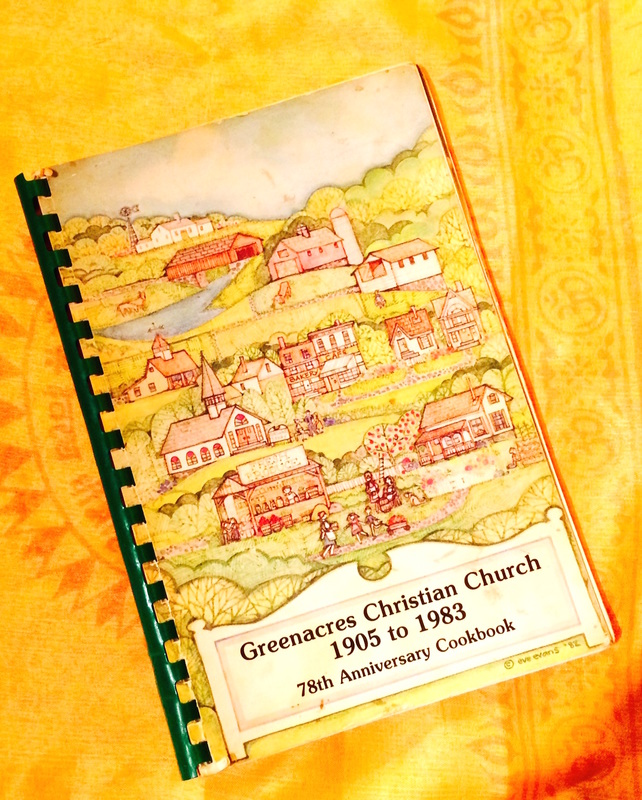Rows of tiny shot glasses are lined up on the counter at my eye level, sparkling clean, dazzling in the kitchen light, and my salivary glands spurt into action as a pitcher carefully fills each with deep purple liquid, and my grandmother places each onto a silver communion tray. The tray is carried upstairs to the church where the baptized will reverently throw back the shots and I remain behind in the basement, happily guzzling my juice from a regular sized glass. It’s 1967 at Greenacres Christian Church and the blood of Christ comes from a Welch’s grape juice can.
My memories of upstairs are few: nuzzling next to my Grandma Esther’s solid body on the pew, wrapped in a second-hand black wool coat I adored, the pastor’s voice lulling me to sleep; hearing my grandmother enthusiastically singing the psalms, high and slightly off-key; singing Christmas carols in the choir, dressed in red robes, my first taste of the stage. Downstairs, though, was the throbbing heart of the church to me, where women in homemade aprons bustled around in the kitchen stirring, cooking, chatting amiably, and set out their most popular dishes for the Sunday potluck the likes of sweet and sour frankfurters, Jell-O and marshmallow salads, and the most heavenly pink chiffon pie Louise, the organ player, always made.
When my grandma gave me a spiral-bound cookbook compiled of recipes from all the church ladies (and a few men) in the early Eighties, I was thrilled! Here in my hands was a time machine to first and second grade. Reading the recipes brought me right back to that noisy basement, and the sunny grass area outside the church where I ran wild with my cousins stopping by the loaded tables to grab a bite of grandma’s rhubarb bread. Now, over 30 years later, the book still sits on my shelf, well-thumbed, a rusty paperclip marking the equivalents and substitutions page. I feel a melancholy jab in my chest and a tight feeling in my throat as I read my grandma’s name under a recipe or two in the yellowed pages.
This popover recipe is so simple I have it memorized, yet I enjoy taking the book down and flipping through to find it. Nowadays I substitute the milk with almond milk, and they puff up just fine with no difference in the taste. Split them open when they’re hot, spread with butter and be transcended.
My memories of upstairs are few: nuzzling next to my Grandma Esther’s solid body on the pew, wrapped in a second-hand black wool coat I adored, the pastor’s voice lulling me to sleep; hearing my grandmother enthusiastically singing the psalms, high and slightly off-key; singing Christmas carols in the choir, dressed in red robes, my first taste of the stage. Downstairs, though, was the throbbing heart of the church to me, where women in homemade aprons bustled around in the kitchen stirring, cooking, chatting amiably, and set out their most popular dishes for the Sunday potluck the likes of sweet and sour frankfurters, Jell-O and marshmallow salads, and the most heavenly pink chiffon pie Louise, the organ player, always made.
When my grandma gave me a spiral-bound cookbook compiled of recipes from all the church ladies (and a few men) in the early Eighties, I was thrilled! Here in my hands was a time machine to first and second grade. Reading the recipes brought me right back to that noisy basement, and the sunny grass area outside the church where I ran wild with my cousins stopping by the loaded tables to grab a bite of grandma’s rhubarb bread. Now, over 30 years later, the book still sits on my shelf, well-thumbed, a rusty paperclip marking the equivalents and substitutions page. I feel a melancholy jab in my chest and a tight feeling in my throat as I read my grandma’s name under a recipe or two in the yellowed pages.
This popover recipe is so simple I have it memorized, yet I enjoy taking the book down and flipping through to find it. Nowadays I substitute the milk with almond milk, and they puff up just fine with no difference in the taste. Split them open when they’re hot, spread with butter and be transcended.



 RSS Feed
RSS Feed